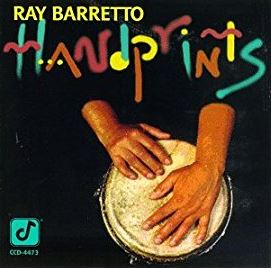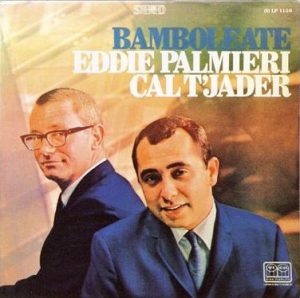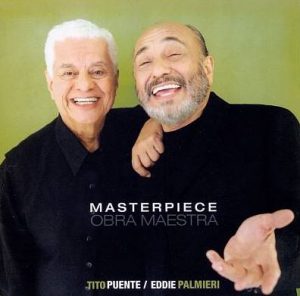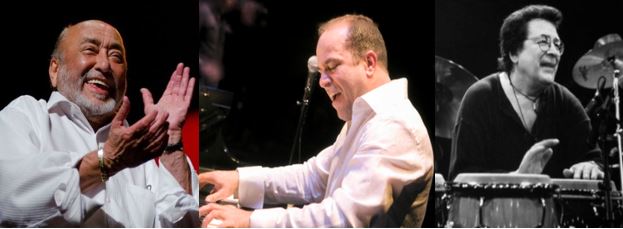This post is also available in:
 Español
Español
In this interview with the Director of the Spanish Harlem Orchestra, Oscar Hernandez shares his views on the dilemma some artists have of playing Salsa vs. Latin Jazz.
In this blog, Oscar shares his views not only on his own dilemma, but also on the frustration he shared with Ray Barretto while a member of his band, and his take on Eddie Palmieri’s decision to focus more on Latin Jazz.
Playing Salsa vs. Latin Jazz
This whole topic started out of my curiosity to know if Oscar started his Latin Jazz Quintet “Alma Libre” for the same reasons others before him had done it.
Tito Puente had a Latin Jazz Ensemble as well as his Big Band to play “Salsa”. Ray Barretto and Eddie Palmieri also had their Salsa orchestras and switched to focus more on Latin Jazz.
Oscar played with Ray Barretto a few years before joining Ruben Blades in the mid-’80s. After Oscar left Barretto, Ray continued to record and play mostly Salsa until the early 90s. At that point he shifted his focus to Latin Jazz, singing with Concord Picante.
Did Oscar form Alma Libre following the path laid out by Puente, Barretto, and Palmieri?
In this part of my virtual café (as I called my interviews) with Oscar Hernandez, he talks about his dilemma on playing Salsa vs. Latin Jazz.
Barretto’s Frustrations and Dilemma
Some time ago I read an article in which Barretto described his frustration with his Salsa band. He said that was the reason he dedicated most of the later part of his career to his Latin Jazz band.

Ray Barretto is quoted saying that “Tito Puente got it right”, in reference to the famous timbalero’s decision to focus on his Latin Jazz Ensemble. Apparently, Tito had grown frustrated with the lack of work and intense management his Big Band required. It was with the big band that Puente played Salsa. His Ensemble mostly used a reduced number of musicians.
Tito Puente, who throughout his long career had alternated between Latin Jazz (Afro-Cuban Jazz, as he preferred to call it) and Salsa (he would never use this term for his music), focused more on his Ensemble starting in the early 80s. However, is worth noting that he always kept playing Salsa, even if sporadically. His very last album, which he recorded with Eddie Palmieri, was mostly a Salsa album.
Perhaps Barretto’s quote came after noticing that Puente made the shift a decade before he did. Puente read the waves of the shifting music scene like an experienced California surfer.
Since Oscar Hernandez played with Ray Barretto before joining Ruben Blades, he knew of Barretto’s frustrations and dilemma. In this part of our conversation, Oscar talks about Ray Barretto’s frustrations with his Salsa band, and Barretto’s immersion into Latin Jazz.
Eddie Palmieri: Another Musician that Loves Salsa and Latin Jazz
The other example I mentioned to Oscar Hernandez was Eddie Palmieri. Eddie is another one of the Salsa and Latin music great bandleaders to alternate his music between Salsa and Latin Jazz.
Early in Eddie’s career, Palmieri recorded a pair of Latin Jazz albums with vibraphonist Cal Tjader. However, these were almost exceptions, as through the ’60s and 70’s Palmieri focused mainly on his Salsa music.

However, it’s worth noting that Eddie liked to infuse these albums with elements of Latin Jazz. For example, he usually included one or two songs of mostly instrumental songs. These songs allowed his band members to do solos, in a similar way to what he does today with his Latin Jazz band.
In the period between the late 70s and early 90s, Palmieri recorded a series of albums, each a little different and with different personnel. But most of these albums centered around Salsa, with sprinkles of fusion and Latin Jazz among them.
It wasn’t until the mid-1990’s that Palmieri began to switch his focus mainly to Latin Jazz. “Palmas” was the first of these albums. It earned him his first Latin Jazz nomination for a Grammy. Unlike Barretto, Palmieri did not and has not left Salsa. His recordings from the late 90s until the first decade of the 2000s were mixed between Salsa and Latin Jazz. However, most have been focused on the latter.
In this last piece of my conversation with Oscar Hernandez, he touches on the case of Eddie Palmieri in this mixture of playing Salsa and Latin Jazz. In Oscar’s opinion, Eddie Palmieri is at heart a Salsa artist first. If Oscar is correct, then Palmieri is just like Ray Barretto and himself; Salsa artists first.
Today’s Need to Play Salsa and Latin Jazz
Tito Puente was really “The King”. As one of the “Big Three” (along with Machito and Tito Rodriguez), Puente always recorded and performed Afro-Cuban music on the Jazz side (or Latin Jazz) and on the Salsa side (with Guarachas, Boleros, Son Montunos, etc.).
Artists like Ray Barretto and Eddie Palmieri have always had the love for the Afro-Cuban Jazz that Machito developed with Mario Bauza. They lived it and played it early in their careers.
Barretto was part of the Tito Puente Orchestra early in his career. He also recorded some Latin Jazz-infused albums early. Eddie Palmieri did a couple of Latin Jazz albums with Cal Tjader in the 60s. These guys used to run between the Palladium and Birdland in Manhattan to witness the best of both worlds.

However, both Barretto and Palmieri were mainly Salsa artists. Their switch towards Jazz in the early to mid-90s respectively could be considered circumstantial. Had Salsa music remained as popular and commercially viable from the mid-80s through today as it was from the 60s through the mid-’80s, perhaps both would have remained recording and performing mainly Salsa music.
But the circumstances changed, and Salsa was not, and arguably is still not, as commercially viable. I say arguably because clearly, some artists are making good money on Salsa. But this is the newer Pop Salsa, which uses elements of Salsa Romantica with Latin Pop and (more recently) Urban music. Artists like Marc Anthony, Victor Manuelle, and Gilberto Santa Rosa are making a killing with this variation of Salsa.
Old school Salsa bands like El Gran Combo and the Sonora Ponceña are still in demand. However, they survive on their past fame combined with heavy travel to hot Salsa markets like South America.
Salsa Lives Despite Change in Latin Music
This is not the Salsa we are talking about here. We are talking about the classic Salsa of the ’60s and ’70s. This Salsa draws from the original concept of hard swinging montunos and individual solos, with a more contemporary lineup of instruments and Jazz-inclined arrangements.
What I just described above, is the Salsa that the Spanish Harlem Orchestra and other bands still working in the Salsa Clasica arena are embracing.
This Salsa is so good that it’s almost a shame to dance it if you are watching it live. Instead, it’s more like the experience of watching Wynton Marsalis perform with the Jazz at the Lincoln Center Orchestra. You just want to sit there and watch these musicians give the best of what they have both individually as well as in mutual harmony. Perhaps that is why it is in hot demand in Jazz Festivals around the world.
Nonetheless, the fact remains that Salsa Clasica is not as commercial as it used to be. This means artists need to find other ways to make a living. The format and demand for Latin Jazz provide an avenue for these artists to play the music that they like. Additionally, it allows them to keep playing the Salsa they like, even if part-time, by complementing it with Latin Jazz performances.
Oscar’s ambivalent summary says it best; “… in a perfect world I wish I could do both…” and then adds…”in a perfect world if I just did Spanish Harlem Orchestra, and we worked enough, that would make me happy…”

